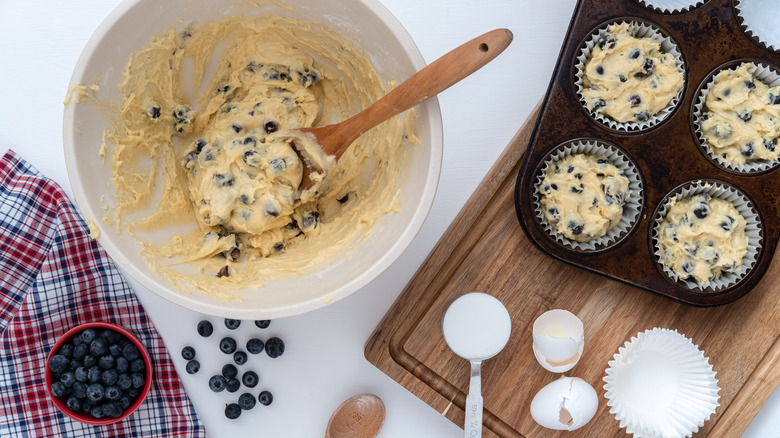What Happens If You Undermix Muffin Batter?
The perfect muffins come out moist and beautifully domed. So, when your muffins don't turn out that way, that's a clear sign that something went wrong. Because most people worry about overmixing their batter, the blunder of undermixing is one they never anticipate. Even more regrettable, unlike the irreversible error of overmixing, undermixing means you could have done more. To prevent this, you need to know exactly how to mix muffin batter and when (not) to stop.
The term "The Muffin Method" describes the process of adding wet ingredients to dry ingredients when making muffin batter. This is the first step to kick off the process of gluten strands forming, followed by mixing the batter. You want to avoid overmixing, since the more you mix your flour, the more gluten strands form to create a dense batter.
But, we don't want to avoid gluten strands completely as they are essential in forming the perfect muffins. Otherwise, with weak or no gluten strands formed, there's no elastic structure to accommodate the air bubbles that form as your batter attempts to bake and rise into domed muffins. Instead, you may end up with irregularly shaped muffins that have flat tops in some areas and risen ones in others, with specks of unincorporated flour in the dough. Although they may taste just fine, you can also tell by their coarse crumbs and a gummy layer of unrisen dough at the bottom that they are the products of undermixing.
How to achieve well-mixed muffin batter
The ideal mixing formula for making the perfect muffins must then lie between forming excess and forming weak gluten strands. This sweet spot is what'll get you a tender muffin texture with no tunneling, which is what happens when you overmix batter. Instead of the air bubbles being retained to form light-textured muffins, they become trapped, resulting in large air pockets that form tunnels through your muffins.
To avoid undermixing muffin batter, combine wet and dry ingredients until the latter are completely incorporated. Mix for 15 to 20 light strokes so that the batter still contains small lumps but has no trace of flour or any other dry ingredients. If you're including any add-ins, now is the time to chuck them in. Even those are to be folded in gently only after the dry ingredients are fully integrated.
There are several other tips for making the best muffins, but one of our favorites is this: You'll know your muffin batter is ready when it's thick but loose enough to drip off the spoon in clumps. Don't continue mixing in an attempt to beat the lumps out of the batter. Those lumps are a sign that your batter is still healthy, and further blending will lead to an overmixed batter. After all, it's better to work your way from undermixed to well-mixed batter than it is to be stuck with the impossible task of salvaging overmixed batter.

